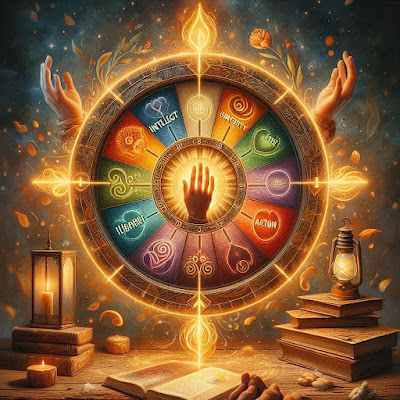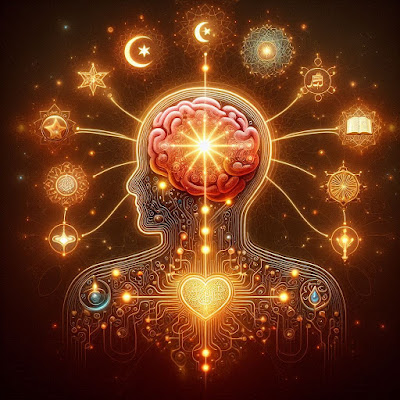From Head to Heart: Integrating Mind, Spirit, and Action for Lasting Transformation
How Islamic Spirituality, Neuroplasticity, and Personality Theory Illuminate the Path from Knowledge to Sincere Deeds
“And when you have decided, then rely upon Allah. Indeed, Allah loves those who rely [upon Him].”
— Qur’an, 3:159
The Intellect as Compass, the Heart as Throne
In a podcast with Opera recently, Mel Robins explained a profound observation about anxiety: as long as we remain inactive, we are trapped in the mind — endlessly spinning in loops of thought. But the moment we act, our thoughts begin to descend into the heart.
This psychological insight resonates deeply with a timeless spiritual truth, especially in Islamic tradition.
The ‘aql (intellect) was never meant to be a cage. It is a compass, a guide pointing toward truth and righteousness. But lingering in endless thought without moving into heartfelt, embodied action risks what the Qur’an describes as “Qulūbun lā yafqahūna bihā” (7:179) — hearts that do not understand, locked away from divine perception.
In Islam, the qalb (heart) is the seat of ikhlāṣ (sincerity), yaqīn (certainty), and divine illumination. Knowledge becomes truly transformative only when it descends from the mind into the heart — and then flows outward into sincere action.
The Pen as a Sacred Catalyst
The pen, al-qalam, holds a sacred place in Islamic spirituality. Tradition tells us it was the first thing Allah created, and it was commanded to write all that will be.
When we write reflectively and sincerely, the brain, heart, and hand align. Abstract ideas crystallize, anxiety softens, and scattered thoughts become coherent. The invisible becomes visible, the unseen (ghayb) manifests in the material (‘ālam al-shahādah). This integrated action anchors knowledge deeply within us.
Neuroplasticity and the Heart-Mind-Body Connection
Modern neuroscience reveals how this process works on a biological level. Neuroplasticity — the brain’s ability to reorganize itself by forming new neural connections — depends heavily on repeated, engaged experience.
When the intellect engages in reflection and then transitions into heartfelt action (such as writing, prayer, or dhikr), it activates different neural pathways that reinforce emotional regulation, empathy, and spiritual cognition.
-
Dopamine-driven pathways fuel motivation, discipline, and goal-directed behavior.
-
Oxytocin and serotonin pathways support connection, trust, and emotional bonding.
-
The limbic system (emotional brain) works with the prefrontal cortex (executive intellect) to harmonize reason with feeling.
When these systems engage holistically — as through the act of writing or prayer — we rewire our brain for deeper spiritual presence, healing, and transformation.
MBTI and Spiritual Activation: From Head to Heart to Limb
Understanding personality type through the MBTI (Myers-Briggs Type Indicator) sheds light on how this integration unfolds uniquely in each person.
For example, INTJs — like myself — are naturally dominant in introverted intuition and extroverted thinking. We live in the realm of abstract ideas and strategic plans (head). However, our weaker functions (introverted sensing and extroverted feeling) require deliberate activation to balance us emotionally and socially.
Studies and personal experience show that for INTJs, activating the heart center often requires oxytocin stimulants — such as reading romantic fiction or engaging in sincere writing. This shifts the balance from pure dopamine-driven motivation to a more integrated neurochemical state, facilitating emotional connection and spiritual openness.
Thus, the spiritual path requires moving from head → heart → limb:
-
Head: Intellect and learning — acquiring knowledge and understanding.
-
Heart: Emotional and spiritual engagement — internalizing knowledge with sincerity and love.
-
Limb: Embodied action — manifesting knowledge through sincere deeds.
This sequence echoes Islamic teachings: action without heart is mechanical; heart without knowledge is naive; and knowledge without action is sterile.
Two Pathways from Knowledge to Action
-
Head → Limb: The legalistic, ego-driven path.
This path depends on willpower (dopamine), discipline, and personal striving. It is necessary but incomplete without heart involvement. Actions may fulfill religious duties but lack spiritual vitality. -
Head → Heart → Limb: The prophetic path.
Knowledge descends into the heart through Qur’anic reflection, dhikr, du‘ā, and sacred writing. Actions flow naturally from this alignment, infused with nūr (divine light), sincerity, and blessing.
This second pathway aligns with neuroplastic principles: by repeatedly activating heart-centered pathways, we reshape our inner landscape and personality. It embodies Jung’s vision of psychological integration, where the self evolves beyond rigid typologies.
The Divine Circuitry of Transformation
Allah, the Prophet ﷺ, and the Imams (ʿalayhim al-salām) are not distant figures but spiritual realities woven into the very fabric of our being when the heart is opened. Writing, prayer, and remembrance are acts that “wire” our soul to divine presence.
This sacred wiring transforms anxiety into peace, confusion into clarity, and rigidity into flow.
Conclusion: Let the Head Guide, the Heart Sanctify, and the Limb Serve
The intellect is a compass, the heart a throne, and action a servant.
Let knowledge guide you, sincerity sanctify you, and action serve you.
Only then do our deeds rise to Allah as fragrant offerings and return as spiritual growth.
Suggested Reading and References
-
Islamic Texts:
-
The Qur’an, especially Surahs Al-A‘raf (7:179), Al-‘Imran (3:159), and related tafsir on qalb and aql.
-
Ibn al-Qayyim’s Madarij al-Salikin on heart purification.
-
Imam Al-Ghazali’s Ihya Ulum al-Din on knowledge and action.
-
-
Neuroscience:
-
Dr. Rick Hanson, Hardwiring Happiness (on neuroplasticity and emotional integration).
-
Dr. Lindsay C. Gibson, Adult Children of Emotionally Immature Parents (for psychological insights).
-
Studies on oxytocin and serotonin in emotional bonding and spirituality.
-
-
MBTI and Personality Growth:
-
Carl Jung’s Psychological Types.
-
Research on cognitive functions and neuroplasticity.
-
Practical guides on activating weaker MBTI functions through targeted activities (e.g., reading and writing).
-
Would you like me to help you with:
-
A detailed section on journaling and writing exercises aligned with this head-heart-limb model?
-
A list of recommended readings, including modern romance fiction and Islamic spiritual classics tailored to INTJs or other types?
-
Further exploration of neurochemical pathways (dopamine, oxytocin, serotonin) and their activation through spiritual practice?










Comments